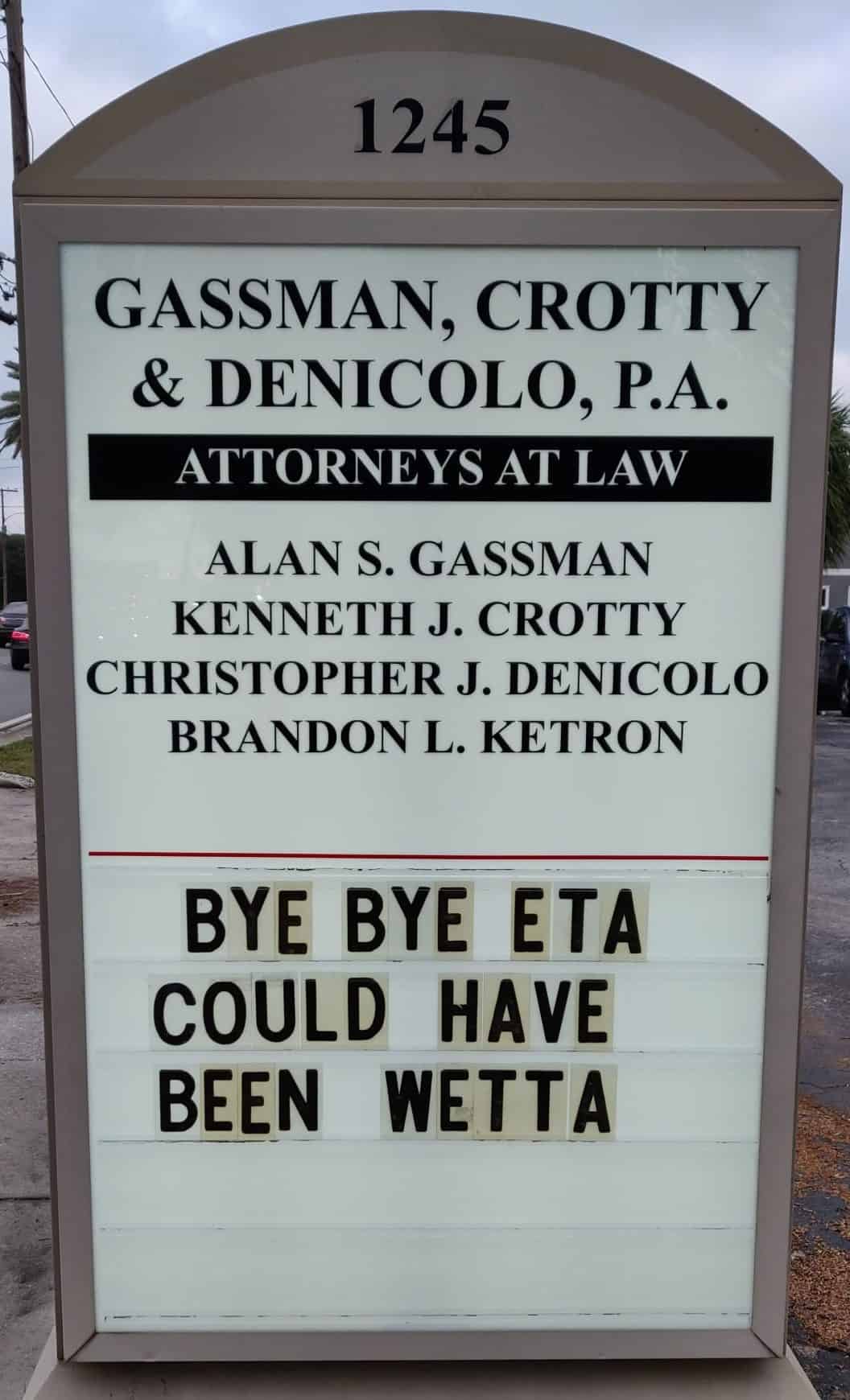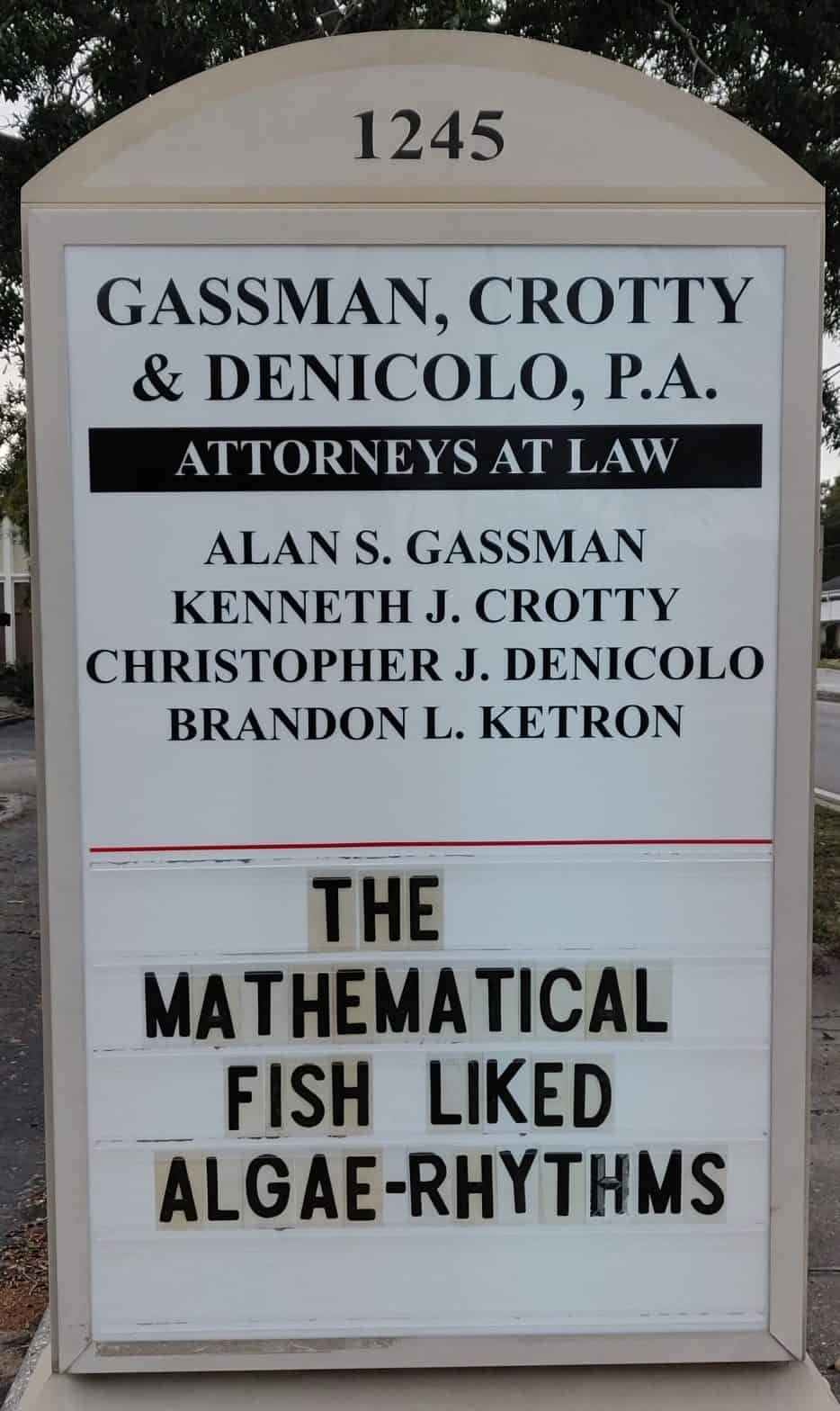The Thursday Report – Issue 293


ALWAYS FREE, SOMETIMES PUBLISHED ON THURSDAYS
Thursday, November 19, 2020 – Issue 293
Having trouble viewing this? Use this link
Termination of Charitable Lead Annuity Trusts, Why and How
Upcoming Events
The Upcoming 8th Annual Great Lakes Asset Protection Institute Agenda
Book Review from Trusts and Estates Magazine
Recent Developments
For Finkel’s Followers
Humor
Termination of Charitable Lead Annuity Trusts, Why and How
Alan Gassman, Jerry Hesch, John Beck



EXECUTIVE SUMMARY:
Charitable Lead Annuity Trusts (“CLATs”) are often the ideal structure for benefitting charities while allowing for significant assets to pass to or for the benefit of family members after several years of charitable payments.
With a “Zeroed-Out CLAT” annual payments are made to charities for a number of years, with a remainder interest passing to family members, even though the entire contribution to the CLAT qualified for the charitable gift tax deduction, and also an income tax deduction. Oftentimes, the remainder interest will be quite large, depending upon what kind of discounting was done when the CLAT was established, and what the rate of return has been on CLAT assets.
Families who have established CLATs may wish to terminate them early so that the charity can receive its future payments early, and family members can receive their remainder interests without further delay. With the COVID-19 pandemic still hammering the U.S. economy, the decision to terminate a CLAT now may be the financial lifeline that families and charities both desperately need.
The IRS has taken a very strict stance to prevent any “discounting” of the charitable interest, but families may still be better off receiving money sooner rather than later, and making sure that their supported charities receive payment than would have otherwise been applicable. There are many good reasons to terminate a CLAT early, as discussed in the article below.
COMMENT:
Why Terminate a CLAT?
Oftentimes, older family members have committed to give charities money for various projects or based upon various timetables the younger family members would prefer to see funded from a pre-existing CLAT, as opposed to having what would have otherwise been part of their eventual inheritance be paid annually to charity.
For example, a CLAT paying $200,000 a year to charity may have 10 years to go, and the creator of the CLAT may have promised $1,000,000 to build a new building for the charity. If the donor donates $1,000,000 then the inheritance of the donor’s children would be reduced by that amount.
If the CLAT can be terminated, then the charity can get a check for $2,000,000, so that both the family and the charity are satisfied that everything has been done in an appropriate manner. It is probably not safe to allow the charitable payments from a CLAT to satisfy a legally binding pledge, but oftentimes “promises made” are not legally binding. Making sure that they are not legally binding is often a good strategy.
There are a number of reasons to terminate a CLAT before its stated term, most notably including the following:
- To allow monies or assets to be delivered to charity earlier in order to meet a family’s charitable objectives without having to put new money in.
- To allow the non-charitable remainder beneficiaries to get money or assets out earlier than would otherwise apply.
- To reduce administrative and reporting obligations and expenses.
- To allow for the funds delivered to charity to be used for purposes not permitted under the self-dealing, excess business holdings, or private foundation rules.
- To avoid the charitable deduction recapture that occurs if the grantor of a “Grantor Trust CLAT” dies during the payment term.
- To allow the non-charitable beneficiaries to invest the funds that they receive early in a manner that would have violated the self-dealing or private foundation rules if such investment was made by the CLAT.
- To allow the non-charitable and charitable beneficiaries get money or assets in times when they desperately need it, which may be the difference in saving a business or investment property, or keeping the doors to the charity open.
Sometimes the non-charitable beneficiary may have an illness or other emergency that may create an immediate need for cash. On a brighter note, elderly individuals may like to see the charity get the money while they are still alive. As Winston Churchill once eloquently stated, “We make a living by what we get; we make a life by what we give.”
Sometimes a donor who has promised to fund the construction of a building for charity, and has been giving above and beyond what the CLAT provides, may wish to terminate the CLAT so that the building may be funded with the CLAT funding, and not the new money that the donor has received. Also, a non-charitable beneficiary may feel that he or she could do a better job of investing the CLAT’s assets by receiving control if he or she is not a trustee, or by not having to follow investment rules that apply to a CLAT if he or she is the Trustee. The CLAT may be prohibited from engaging in certain investments that the non-charitable beneficiary is interested in.
CLATs also generally have administrative costs that would be avoided by terminating the CLAT early. These costs are generally not high, but it does reduce some of the future growth potential.
An early termination is generally beneficial to the charity due to the annuity payment not being discounted for the time value of money. A dollar today is generally worth more than a dollar tomorrow, with the exception of charities that would spend the money unwisely, or not budget judiciously.
CLATs can generally be terminated as long as all of the beneficiaries consent and a court approves the termination. The charity will receive the remaining annuity payments without discounting for the time value of money (in this case the IRC Section 7520 rate) to the extent that the assets of the CLAT are sufficient to pay this, and the non-charitable beneficiaries can presumably receive the assets, if any, that are remaining after payment of costs, trustee fees and any taxes owed by the CLAT.
IRS’ Position on Early Termination
In Revenue Ruling 88-27 1988-1 C.B. 331, the IRS concluded that there could be no discount of what is paid to the charity under an early CLAT termination so that the charity would receive the total dollar amount of all future annuity payments without discounting for the time value of money.
As a result of this ruling, the taxpayers involved would have suffered penalties for failing to comply with the terms of the CLAT, in the view of the IRS, if they had gone forward with an early termination with a discount for the time value of money. Violation of the self-dealing rules can result in penalties equal to 10% of the amount involved in the act of self-dealing, with such penalties imposed on the disqualified person, and a penalty equal to 5% % of the amount involved in the act of self-dealing can be imposed on a foundation manager that is acting only as a manager. The penalties increase to 200% if the self-dealing issue is not corrected in a timely manner. The imposition of this tax can therefore be devastating.
It remains unclear whether a CLAT may be drafted to include language that allows a CLAT to be terminated early, with the charitable beneficiary receiving the balance of the remaining annuity payments, without discounting for the time value of money. Revenue Ruling 88-27 states that a CLAT cannot include such language but was issued in relation to a CLAT that would have provided a discount for prepayment of the charitable beneficiary. Further, in Rev. Proc. 2007-45, the IRS referenced Revenue Ruling 88-27 in a statement that “a charitable lead annuity interest is not a guaranteed annuity interest if the trustee has the discretion to commute and prepay the charitable interest prior to the termination of the annuity period. PLR 9734057 goes even further by taking the position that a CLAT that does not include an anti-commutation clause will not qualify for the estate tax charitable deduction.”
Because the IRS has provided negative guidance in relation to CLATS that have a no commutation clause, it is likely best not to test the waters. We know that court approval may be obtained to terminate a CLAT early, and most individuals creating a CLAT will assume that the CLAT will continue for the full annuity term. Therefore, it seems best to follow Revenue Ruling 88-27, and PLRs 199952093, 9844027, and 200225045, and simply not include early termination language in the CLAT Agreement. Alternatively, such language may be included but should state that it would only apply if and when the law clearly permits such termination to occur without a court order, and based upon what the tax and applicable state law permits when such termination occurs. The PLRs listed above deal with fixed term CLATs, but the authors can think of no reason why a life term CLAT could not be terminated early in the same manner.
Just because a charitable beneficiary is paid out early does not necessarily mean that the non-charitable beneficiaries will receive their portion of trust assets immediately. A CLAT that provides that the non-charitable beneficiary will receive his or her interest in trust may very well be subject to those terms after the charitable beneficiary is paid. In Revenue Ruling 9844027 the trust continued after the charity was paid early, so it would be wise to include language in a court petition for early termination to confirm that the non-charitable beneficiaries will receive distributions early.
The PLRs do not discuss whether the Grantor or a related party serving as trustee of the CLAT can receive a termination fee, but it would seem that it would be acceptable for the trustee of a CLAT to receive a termination fee as long as it is at arm’s-length and commensurate with what similarly situated trustees would receive in similar circumstances. It would also seem reasonable to allow the CLAT to pay the legal fees and filing costs incurred to facilitate the termination, and for research associated therewith.
Early Termination of CLATs
The deference that the IRS provided to the authority of state law in PLRs 199952093, 9844027, and 200225045 raises the question of whether a non-judicial modification would be sufficient, even if state statutes allow for this. In all three of these PLRs, the IRS did not comment on a non-judicial method of modification. While this may be possible, it is safest to have a court sign off on the transaction, especially since the State Attorney General may have an interest in protecting the charitable beneficiary and in order to make it clear to the IRS that state law was followed in the early termination. Further, it would be prudent to follow the guidance provided in PLRs 199952093, 9844027, and 200225045 that explicitly stated that court approval was required.
Another issue that many practitioners have pointed out is that IRC Section 4947(a)(2) seems to indicate that IRC Section 507 will apply to the early termination of a CLAT. IRC Section 507, which applies to the Termination of Private Foundation Status, generally provides for a tax to be imposed upon certain Private Foundation Terminations that are not in accordance with rules that permit for no tax to apply if all assets of a Private Foundation are transferred to a Public Charity or another Private Foundation that are qualified IRC Section 501(c)(3) entities. As long as the charitable beneficiaries are fully paid all amounts that they would have received before any payment is made to the non-charitable beneficiaries, without discounting, and the distributions to the non-charitable beneficiary are not discretionary under the terms of the CLAT Agreement, then IRC Section 507 should not apply to impose tax on an early termination.(i)
When determining the value of the prepayment owed to the holder of a charitable lead interest on an early termination, it might be argued that the charitable beneficiaries could accept less than a full payment amount based upon the valuation principles of IRC Section 7520, in the same way that IRC Section 7520 applies to charitable remainder trusts on an early termination, but this is not the case for CLATs, according to PLRs 199952093, 9844027, and 200225045, which state that the IRC Section 7520 discount rate is not applied in early terminations of CLATs and instructs that the payment to charity will not be discounted for the time value of money. As a result, an early termination will almost always be beneficial to the charity, and it would be hard to image a charitable beneficiary not agreeing to allow for an early termination, unless it was a Private Foundation that could not spend enough of the funds to satisfy the 5% expense/payment requirement, or receipt of a large termination payment would prevent a public charity from meeting one of the public support tests.
Private foundations generally need to spend at least 5% of their assets each year on permitted expenses. Depending on the mission of the charity, it is foreseeable that if a CLAT terminated early, the private foundation may not be able to spend enough of the assets for its specific charitable mission, or that accelerated spending may not be as efficient or as beneficial for the charity and its purposes, so that the private foundation may prefer annuity payments. Public charities that rely on the public support test may not meet this test if they receive a very large contribution from one CLAT termination. Even though the public charity should be aware of this issue and should not agree to the early termination in such event, the non-charitable beneficiary seeking the early termination should consult with a qualified attorney to determine whether the above situations could be an issue.
Conclusion
A CLAT can be a very effective planning tool that can provide charitable income tax and estate/gift tax deductions, depending on how the CLAT is structured and managed. A qualified professional should always be consulted before creating a CLAT to make sure that all applicable laws and regulations are followed, including the private foundation rules that are applicable to CLATs.
There are some legitimate reasons to terminate a CLAT early, including when the donor would like to see an acceleration of what will pass to charity, if the donor has a short life expectancy and deducted the initial CLAT transfer, or if the non-charitable beneficiaries would like to receive their remainder interest early, and do not mind having the charities receive their payments early and without discounting.
If the structure of the CLAT no longer serves the purpose that the CLAT was designed to satisfy, it is possible to terminate the CLAT early. Careful thought should be put into the financial consequences of an early termination, because the charity will receive a lump sum equal to the remaining annuity payments, without discounting for the time value of money.
“Since you get more joy out of giving joy to others, you should put a good deal of thought into the happiness that you are able to give.” –Eleanor Roosevelt.
We Hope That This Helps You Help Those Who Simply Cannot Wait For Their CLAT Benefits!
CITE AS:
LISI Charitable Planning Newsletter #302 (October 15, 2020) at http://www.leimbergservices.com Copyright 2020 Leimberg Information Services, Inc. (LISI). Reproduction in Any Form or Forwarding to Any Person Prohibited Without Express Permission. This newsletter is designed to provide accurate and authoritative information in regard to the subject matter covered. It is provided with the understanding that LISI is not engaged in rendering legal, accounting, or other professional advice or services. If such advice is required, the services of a competent professional should be sought. Statements of fact or opinion are the responsibility of the authors and do not represent an opinion on the part of the officers or staff of LISI.
CITATIONS:
UPCOMING EVENTS
FREE WEBINARS FROM OUR FIRM ARE HIGHLIGHTED IN BLUE
| When | Who | What | How |
|---|---|---|---|
| Thursday, November 19, 2020 | Clearwater Jazz Holiday Foundation |
Alan Gassman sponsors: Wanderlust – A Reimagined Live Music Experience for 2020 from 6 to 9 PM EST |
Register |
| Thursday, November 19, 2020 | FICPA Scholarship Foundation |
Gassman, Denicolo & Ketron, P.A. sponsors: The 16th Annual Suncoast Scramble Golf and Wine Tasting event |
More Information |
| Tuesday, November 24, 2020 | CPA Academy |
Alan Gassman and Brandon Ketron present: Save Estate Tax To The Max: Year End Gift And Estate Tax Planning from 5:30 to 6:30 PM EST |
Register |
| Wednesday, November 25, 2020 |
Free webinar from our firm |
Alan Gassman presents: Florida and Federal Creditor Exemption Update: 2020 Developments that can Impact Client Planning from 12:30 to 1 PM EST | |
| Tuesday, December 01, 2020 | Ohio State Bar Association’s Great Lakes Asset Protection Institute |
Alan Gassman presents: Ten Examples of Asset Protection Plans that have Worked from 9 to 10:30 AM EST |
Register |
| Tuesday, December 01, 2020 | Ohio State Bar Association’s Great Lakes Asset Protection Institute |
Alan Gassman participates: In a panel discussion from 4:30 to 5 PM EST |
Register |
| Friday, December 04, 2020 | Free webinar from our firm |
Alan Gassman, Ken DeGraw and Michael Markham present: Subchapter V – And Recent Bankruptcy Law Developments from 12:30 to 1:15 PM EST |
Register |
| Friday, December 4, 2020 | Leimberg Webinar Services (LISI) |
Jerry Hesch, Alan Gassman and Brandon Ketron present: What The CRUT? Is It Time to Put One Up? From 1 to 2:30 PM EST |
Register |
| Thursday, December 10, 2020 |
FICPA Federal Tax Conference | Alan Gassman and Brandon Ketron present: Implementation of TCJA guidance from 9 to 9:50 AM EST | Register |
| Thursday, December 10, 2020 | FICPA Federal Tax Conference |
Ken Crotty and Christopher Denicolo present: Hot Topics and Planning Strategies for S and C Corporations from 2:50 to 3:40 PM EST | Register |
| Tuesday, December 15, 2020 | Palm Beach County Bar Association |
Alan Gassman and Brandon Ketron present: 2020 Year End Planning |
More Information |
| Tuesday, January 12, 2021 | CPA Academy |
Alan Gassman and Michael Lehmann present: Summary of Restrictions Applicable to Different Types of Entities from 5:30 to 6:30 PM EST |
Coming Soon |
| Friday, January 29, 2021 | Florida Bar Health Law Section: Representing the Physician |
Alan Gassman presents: Medical Practices And PPP, EIDL, and Provider Relief Fund Planning and Implications |
Coming Soon |
| Thursday, February 11, 2021 | Johns Hopkins All Children’s Annual Estate Planning Seminar |
Alan Gassman: Introduces speakers and listens carefully |
Register |
| Tuesday, February 23, 2021 | New Jersey State Bar Association |
Alan Gassman presents: WHAT YOUR BEST CLIENTS NEED TO KNOW ABOUT FLORIDA LAW AND PLANNING from 4:30 to 5:30 PM EST |
Coming Soon |
| Friday, March 26, 2021 | Florida Bar: Tax Section |
Alan Gassman and Leslie Share present: Creditor Protection Nuts & Bolts |
Coming Soon |
| Thursday, May 13, 2021 | FICPA-FSU Spring Accounting Conference |
Alan Gassman presents: Topic to be determined |
Coming Soon |
Call us now! Bookings accepted for haunted houses, bar mitzvahs, weddings, seminars, and symposiums (or symposia)!
The Upcoming 8th Annual Great Lakes Asset Protection Institute Agenda
REGISTER HERE
- 8:45 Welcome From the Planning Chair and Institute Sponsor
- Michael J. Stegman, Esq.; Kohnen & Patton, LLP; Cincinnati
- 8:50 Opening Remarks
- Representative William J. Seitz III, Esq.; Ohio House Majority Leader
- House District 30/Partner of Counsel, Dinsmore & Shohl LLP; Cincinnati
- 9:00 Ten Examples of Asset Protection Plans That Have Worked
- Alan S. Gassman, Esq.; Gassman, Denicolo & Ketron, P.A.; Clearwater, Fla.
- 10:30 Break
- 10:45 The Best States for LLCs
- Jessica M. Wojtowicz, Esq.; Jessica M. Wojtowicz, P.C.; Park Ridge, Ill.
- 11:30 Making Use of Private Trust Companies in Ohio
- Cynthia L. Steeb, Esq.; CLS Consulting, LLC; Valley City
- 12:30 Lunch Break
- 1:30 Conducting Due Diligence on Potential Asset Protection Clients (Professional Conduct)
- L. Burke Files, Esq.; Financial Examinations & Evaluations, Inc; Tempe, Ariz.
- 2:30 Exploring Offshore Asset Protection Trust Jurisdictions
- William A. Ensing, Esq.; Ensing Law Firm.; Lake Forest, Ill.
- 3:30 Break
- 3:45 Case Law and Statutory Update/Panel Discussion
- John E. Sullivan III, Esq.; Sullivan & Sullivan Ltd.; Beachwood
- D. Bowen “Bo” Loeffler, Esq.; The Loeffler Law Firm LLC; Port Clinton/Sandusky
- 5:00 Seminar Concludes
Book Review from Trusts and Estates Magazine
Alexander Bove

What Estate Planners (and Others) Need to Know About Bankruptcy (Alan Gassman, et al.)
This new reference material tackles numerous issues from a tax and estate-planning point of view.
As a dedicated estate planner for more years than I care to admit, there’s been one subject that kept surfacing in my practice, then subsiding without leaving much information behind—that subject was bankruptcy and all its related issues. Not that the subject wasn’t important enough for me to research it, it’s just that it’s so specialized and arose so sporadically, it didn’t warrant taking a course in it or hitting any of the mass of heavy volumes on the subject. My own personal wish was, if only there was a manageable, authoritative reference I could use to answer some of the questions that advisors, estate planners in particular, typically confront; such as, what are the special fraudulent conveyance rules in bankruptcy? Can a bankruptcy trustee reach the assets clients place in children’s trusts? Are clients’ limited liability company interests protected in a bankruptcy? Are there some assets that are protected if a client later has to file for bankruptcy? Are there some transfers that are protected if a client later files for bankruptcy? What about asset protection trusts that a client establishes in a state like Delaware or South Dakota?
Answers to These Questions
Finally, there is such a work, just recently published, that addresses all of these and the numerous related questions. Attorney Alan Gassman, along with Alberto Gomez, Michael Markham, Adriana Choi and Lawrence Heinkel, have accomplished what might appear to be an impossible task: to analyze the numerous issues generated in a bankruptcy proceeding from a tax and estate-planning viewpoint, and they do it in about 150 pages.
Two of the more common issues planners typically face when a client faces or is contemplating a bankruptcy filing are the question of preferential transfers and exposure to fraudulent transfers. A preferential transfer is often distinguished from a fraudulent transfer on the basis that a fraudulent transfer by definition is one in which the client/transferor doesn’t receive fair value for the transfer. Clearly, an outright gift, for example, or the “sale” of a $50,000 asset for $7,500, would be a fraudulent transfer, but when a client pays off a legitimate $50,000 note due to his parents just months before filing bankruptcy, that’s what’s known as a preferential transfer, and as the Gassman group tells us, the bankruptcy court can order the parents to return the payment to the court to be counted with the client’s other assets. Thus, a planner’s advice to a client that he should pay off certain debts before filing would be bad advice and could result in a claim against the planner. But what if the client, who is about to file bankruptcy, owes fees to the planner. May these fees be paid before bankruptcy? According to the Gassman group, “reasonable compensation paid for services rendered will not be considered a preferential transfer, and so should be permitted,” but that rule probably wouldn’t apply, for example, to a previous outstanding debt to the planner.
The list of topics is exhaustive, and there are plenty of cites if one wishes to research the topic as well as a brief discussion of key cases on many issues. The book is truly unique in its practical and informative coverage of so many estate-planning points related to bankruptcy. I recommend it highly as a reference that belongs in every estate planner’s library.
Recent Developments
Martin Shenkman

A recent Bankruptcy case may have important implications to estate tax minimization and asset protection planning. The Court in the Rensin case found that an existing asset protection trust administered in Belize was subject to Florida law and not the laws of Belize. That conclusion could have undermined the entire trust and plan. In this case, because the trust assets were invested in annuities, they were ultimately protected from creditors under Florida law. However, the application of Florida law instead of Belize law (which some commentators believe is an error) has important planning implications to anyone who is the settlor and beneficiary relying on domestic or offshore asset protection trusts. You must consider this possibly increased risk that courts may apply the law of the state of your residence (e.g. New York) instead of the law of the state where the trust has situs and is administered (e.g. Alaska). Example: You set up a self-settled trust in Nevada and you are a beneficiary. Your goal is to make a completed gift of assets to that trust to use your current gift tax exemption – i.e. to get the assets outside your estate before the estate tax laws change. However, if a court applies the Rensin approach, New York law, not Nevada law, might apply to the trust. This could permit New York creditors to reach those assets. One of the tests for whether you have removed assets from your taxable estate is that your creditors cannot reach them. If Rensin could result in creditors reaching those assets, your estate tax plan could be undermined. From an asset protection perspective you might consider using a “belt and suspenders” approach. For example, have your trust own less than 100% interests in multiple member LLC’s and limited partnerships that have charging order protection. If you are really worried, perhaps you should move to a DAPT friendly state. Some commentators might suggest that you move the trust offshore to avoid the application of the full faith and credit clause of the U.S. Constitution. But you must consider possible contempt of court and other risks. It is not clear whether what appears to be incorrect legal reasoning will apply in future cases, or that a bankruptcy court decision will affect non-bankruptcy decisions, but caution is in order. In re Rensin, 17-11834 -EPK, 2019 WL 2004000 (Bankr. S.D. Fla. May 6, 2019).
Is The Price Too High?
David Finkel

If you are an entrepreneur, chances are you are working too many hours and focusing on the wrong things. Generally speaking, we are working more hours and taking less vacation than ever before and suffer from more anxiety and stress than previous generations. While this isn’t a new issue for business owners, it’s one that really should be addressed before it gets worse.
Thirty years ago, Boyd and Gumpert (1983) suggested that 60% of SME owner-managers worked more than 50 hours a week, with 25% working over 60 hours. More recently, similar numbers were reported by Torres (2012), who also noted that 60% of owner-managers took three weeks’ vacation or less per year and 10% took no vacation at all.
So today I want to look at the psychological cost of being an entrepreneur. What happens when you invest all your physical, financial and intellectual capital on one single asset: your business? What is the true cost of such a decision?
Burnout
As a business coach for over twenty five years, I see a lot of business owners on the brink of burnout. Brilliant individuals with a passion for their industry and their product come to me ready to quit. They are tired of working seventy hours a week and their family life is suffering. And over time the burnout leads to other issues.
In order to combat burnout, it is imperative that you take time for your family and your friends. Structure your business in a way that you can step away for an extended period of time without sacrificing growth or sales. This can be done through a series of systems and controls as well as developing a leadership team that has the strategic depth to handle the business while you are away.
Depression
Depression and anxiety is another psychological cost of being an entrepreneur. Working long hours in isolation with no one to turn to for advice or help can quickly turn into something more serious. And that coupled with problems at home can really impair your ability to grow your business and feel fulfilled.
The best way to combat these feelings of depression and anxiety is to join a mastermind group, find a business coach or get a mentor. Having someone who is in your corner to bounce ideas off of and discuss your business can help you scale and grow in a way that is healthy for both you and your business.
Poor Judgement
If you are burning the candle on both ends and focusing too much on your business, efforts get scattered and poor decisions get made. This leads to underperformance, which pushes you to chase after more control to set things back on the right path, which further robs the business of depth as you’re not prioritizing your time. It’s a negative reinforcement loop.
Lack of clarity is evident when you feel like you spend your days putting out fires and unable to come up for air. You are overwhelmed by emails, messages and app feeds. And what do most people do to escape this? They take the easy, low-value tasks first. And spend the weekend and after hours working on the things that they really should have been working on all along.
Keep your judgment sharp by focusing your time on activities that provide the most value for your business. Stop putting out fires and start building your business.
Humor


Gassman, Denicolo & Ketron, P.A.
1245 Court Street
Clearwater, FL 33756
(727) 442-1200
